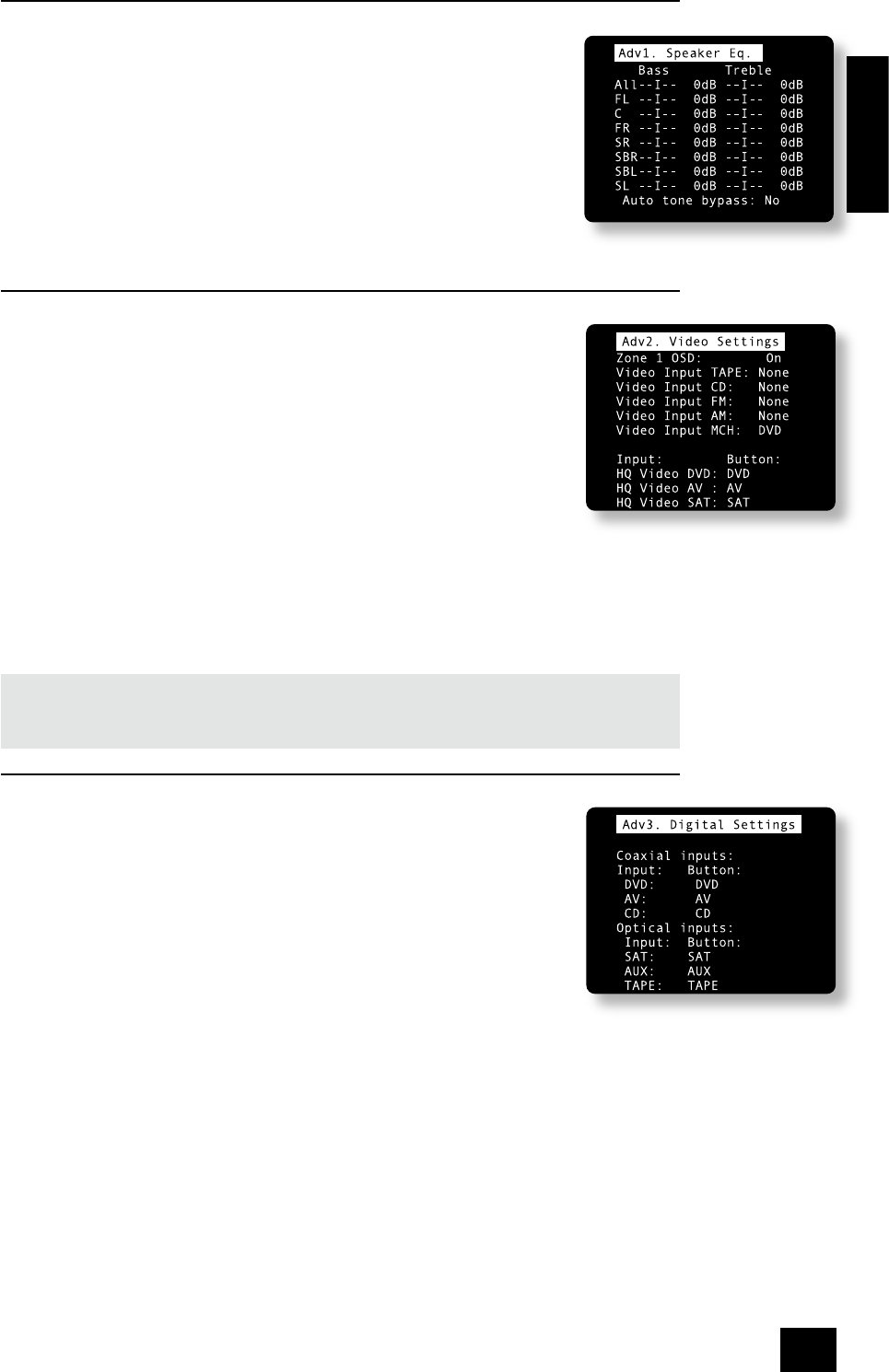
AVR280
17
English
The ‘Advanced’ Set-up Menus
ADV 1 – Speaker Eq.
This allows ne adjustment of bass and treble in 1dB steps (up to ±6dB) for each of the
speakers in the system. Use these adjustments sparingly to compensate for speaker
response problems caused by positioning, adjacent surface textures, or mixed brands of
loudspeakers.
Work with one speaker on at a time and, as an example, use the bass control to reduce
boom problems for speakers placed in corners, and the treble control for speakers
placed near reective surfaces. We recommend trying to obtain a good speaker
response by speaker placement rst, then apply speaker equalisation last.
The tone control nominal corner frequencies are at 100Hz and 8kHz, shelf type.
Auto Stereo Tone Bypass: Set this item to YES if, when a stereo input signal is
detected (analogue or digital), the tone adjustments set on this page are to be by-
passed. (Note that this does not switch the AVR280 into ‘Direct’ mode, it simply sets the
tone controls to zero.)
ADV 2 – Video Settings
This menu allows advanced adjustment of the video settings for your AVR280.
Zone 1 OSD: Selects whether the main zone OSD is on or off.
<
When set to ON‚ all user adjustments that are made during the general use of
the AVR280 are displayed on the screen. This includes the adjustment of the
volume control, the inputs selected and the set-up menus.
<
When set to OFF‚ there will be no display of the general user adjustments – only
the set-up menus and the main menus are displayed.
It is recommended you keep the OSD turned ON‚ since if you cannot see the front panel
of the AVR280 you will have no idea if any adjustments you have made to the processor
are correct or to your liking.
Video Inputs: Composite and S-video inputs for DVD, Sat, AV, VCR and AUX have their
audio and video assigned to track each other by default. The ve ‘Video Input’ lines for Tape, CD, FM,
AM and DVD-A allow assignment of a video source to these normally audio-only sources. If desired, it is
possible to allocate the same video source to more than one audio input. This facility allows you to listen
to an audio source and view a separate video source at the same time – for example, you can listen to
radio while watching TV for a sports simulcast.
HQ Video DVD, AV and SAT: Allocate the high quality component or RGB video inputs to any source
buttons. For example, to assign the Component/RGB video from the ‘HQ Video DVD’ input to the DVD
button, set the ‘HQ Video DVD’ item in this menu to ‘DVD’.
If HQ-VIDEO is set to RGB (as described on page 13) and an HQ-video input is assigned to a button,
the AVR280 assumes that RGB signals are present for that input if a composite signal is found on the
corresponding composite input. If this assignment is made but no RGB signals are supplied, the
display will be blank for the assigned source.
ADV 3 – Digital Settings
Coaxial inputs and Optical inputs. Each of the digital inputs can be assigned to any
of the seven stereo source buttons (CD, TAPE, DVD, SAT, AV, VCR and AUX), or can be
assigned No button.
This menu page lists the physical inputs, as per the back panel, on the left hand side of
the screen, with the buttons used to select the inputs listed on the right hand side.
Each digital input can be allocated only to one source button. For example, if you choose
the ‘Coaxial DVD input’ to be assigned to the DVD button, then the choices for the other
digital inputs are: CD, TAPE, SAT, AV, VCR, AUX and NO BUTTON. If you wish to re-
allocate the DVD input to a different button, ‘Coaxial DVD input’ must be assigned to a
different button (or No button) before you can re-assign the DVD input.
